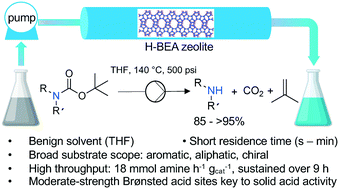Efficient, continuous N-Boc deprotection of amines using solid acid catalysts†
Abstract
N-Boc deprotection (deBoc) is a common reaction in pharmaceutical research and development, as well as pharma manufacturing. Use of a catalyst lowers the required reaction temperature, and heterogeneous catalysts allow the reaction to be conducted in a continuous flow reactor with a low-boiling solvent, facilitating product separation and enhancing efficiency and productivity relative to a batch process. In this study, we explore the use of simple solid Brønsted acid catalysts to achieve continuous N-Boc deprotection of amines, without additional workup steps. Using THF as the solvent, H-BEA zeolite affords high yields of a variety of aromatic and aliphatic amines, often in residence times of less than a minute at 140 °C. The same catalyst/solvent combination is ineffective in batch conditions, due to the much lower temperature of refluxing THF. Boc-protected p-chloroaniline was deprotected with a throughput of 18 mmol p-chloroaniline per h per gcat, sustained over 9 h. The active sites of the zeolite do not appear to be directly associated with the Al framework substitution in the micropores, since partially ion-exchanged Na/H-BEA shows activity similar to H-BEA. The strong Brønsted acid sites (framework [Si(OH)Al]), are likely poisoned by the amine product. Moderate Brønsted acid sites associated with silanol defects near Al on or near the external surface (and not susceptible to Na+-exchange) are presumably the active sites, since they are not poisoned even by more basic aliphatic amines.



 Please wait while we load your content...
Please wait while we load your content...